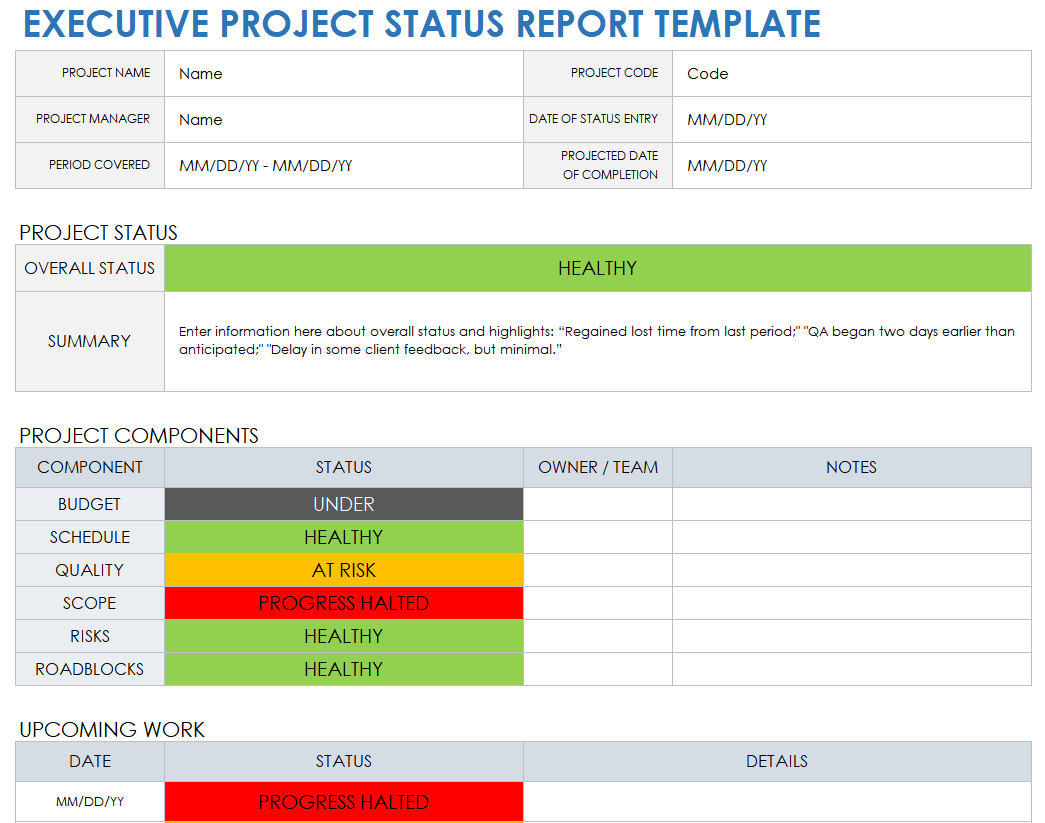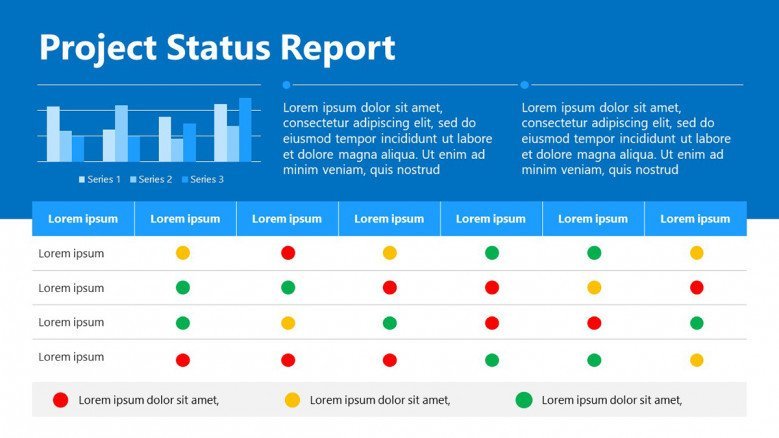A Project Status Report is a critical tool in project management. It provides a snapshot of the project’s current state, tracks progress, and identifies any issues or risks. This report is essential for keeping stakeholders informed and ensuring that the project stays on track. This report helps project managers present information clearly and consistently.
Key Components of a Project Status Report
Following are the key components that are explained below:
1. Project Information
Every Project Status Report begins with basic project information. This includes:
- Project Name: Clearly states the project being reported on.
- Project Manager: Identifies the person responsible for the project.
- Reporting Period: Specifies the time frame covered by the report.
2. Executive Summary
The Executive Summary provides a high-level overview of the project’s status. It highlights key accomplishments, milestones reached, and major issues. This section allows stakeholders to quickly grasp the project’s overall health and progress.
3. Project Timeline
The Project Timeline section outlines the schedule and key milestones. It includes:
- Milestones Achieved: Lists significant milestones completed since the last report.
- Upcoming Milestones: Highlights upcoming milestones and deadlines.
- Schedule Variance: Identifies any deviations from the planned schedule and explains their impact.
Related Article: 7 Steps To Build PERT Chart Analysis Template – PMITOOLS
4. Budget Status
Monitoring the project’s financial health is crucial. The Budget Status section includes:
- Budget Allocation: Details the allocated budget for different project components.
- Actual Expenditure: Tracks the actual spending to date.
- Budget Variance: Identifies any discrepancies between the budgeted and actual expenditures, with explanations for significant variances.
5. Risk Management
Risk Management involves identifying and mitigating potential issues that could derail the project. This section covers:
- Identified Risks: Lists current risks with potential impact on the project.
- Mitigation Strategies: Describes steps taken to address and reduce these risks.
- Risk Status: Updates the status of each risk, indicating whether it is increasing, decreasing, or stable.
6. Issues and Resolutions
Projects often face unforeseen challenges. The Issues and Resolutions section documents:
- Current Issues: Lists active issues affecting the project.
- Impact Analysis: Explains the impact of each issue on the project’s scope, schedule, or budget.
- Resolutions: Details the actions taken or planned to resolve these issues.
7. Progress Summary
The Progress Summary provides a detailed account of the project’s progress. It includes:
- Completed Tasks: Lists tasks completed since the last report.
- Ongoing Tasks: Describes tasks currently in progress.
- Future Tasks: Outlines tasks scheduled for the next reporting period.
Related Article: Top Project Portfolio Tracker Template Download – PMITOOLS
8. Quality Assurance
Quality Assurance ensures that the project meets the required standards. This section includes:
- Quality Metrics: Defines the metrics used to measure quality.
- Testing and Review Results: Summarizes the outcomes of quality tests and reviews.
- Quality Issues: Identifies any quality-related issues and the steps taken to address them.
9. Team Performance
Team Performance assesses the effectiveness and productivity of the project team. It includes:
- Team Achievements: Highlights significant achievements by the project team.
- Resource Utilization: Evaluates how well team resources are being used.
- Training and Development: Notes any training or development activities undertaken to enhance team skills.
10. Stakeholder Engagement
Engaging stakeholders is critical to project success. This section covers:
- Stakeholder Communication: Describes how communication with stakeholders is managed.
- Feedback and Concerns: Summarizes stakeholder feedback and any concerns raised.
- Stakeholder Satisfaction: Gauges the overall satisfaction of stakeholders with the project’s progress.
Related Article: Top 3 Effective Project Procurement Plan Templates – PMITOOLS

The Role of Project Status Reports in Project Management
Following defines the role of project status reports in the world of project management:
Enhancing Transparency
Project Status Reports provide transparency by regularly updating stakeholders on the project’s progress. This ensures everyone remains informed about the project’s current state, including any challenges or changes.
Facilitating Decision-Making
These reports equip project managers and stakeholders with the information needed to make informed decisions. By highlighting key issues and risks, the report enables proactive problem-solving and adjustment of strategies as necessary.
Related Article: Advanced Project Plan Template Excel Download- PMITOOLS
Tracking Progress
Regular status reports help track the project’s progress against its initial plan. This includes monitoring milestones, budget, and schedule, ensuring that any deviations are promptly addressed.
Managing Risks
Identifying and managing risks is a critical aspect of project management. The Project Status Report helps in documenting risks and their mitigation strategies, ensuring that risks are continuously monitored and managed.
Ensuring Accountability
By documenting progress, issues, and resolutions, the Project Status Report ensures accountability. Team members understand their responsibilities and the status of their tasks, which fosters a sense of ownership and commitment.
Enhancing Communication
Effective communication is vital in project management. The Project Status Report serves as a communication tool that keeps all stakeholders, including the project team, informed about the project’s status, fostering collaboration and alignment.
Supporting Project Control
Project Status Reports provide essential data that supports project control activities. By comparing actual progress with planned progress, project managers can take corrective actions to keep the project on track.
Related Article: 10 Tips For Creating Project Schedule Template Excel – Download (pmitools.net)

Creating an Effective Project Status Report Template
Here are some tips to design an effective, user-friendly and a comprehensive Project Status Report Template:
1. Clarity and Conciseness
An effective Project Status Report Template should present information clearly and concisely. Avoid unnecessary jargon and ensure that the report can be easily understood by all stakeholders.
2. Consistency
Using a consistent format for status reports helps stakeholders quickly locate and understand the information they need. Consistency also makes it easier to compare reports over time, identifying trends and patterns.
3. Relevance
Ensure that the information included in the report is relevant to the stakeholders. Focus on key aspects such as progress, risks, issues, and budget status, and avoid overloading the report with excessive details.
4. Visual Aids
Incorporate visual aids such as charts, graphs, and tables to present data effectively. Visual aids can make complex information more accessible and help highlight key points.
Related Article: 8 Tips For Designing Product Roadmap Template – PMITOOLS
5. Regular Updates
Update the Project Status Report regularly, typically on a weekly or bi-weekly basis, depending on the project’s duration and complexity. Regular updates ensure that stakeholders receive timely information and can act on it promptly.
6. Customization
Tailor the template to suit the specific needs of the project and its stakeholders. Different projects may require different levels of detail or emphasis on certain aspects, so customize the template accordingly.
Conclusion
A well-structured Project Status Report Template is a vital tool in project management. It enhances transparency, facilitates decision-making, tracks progress, manages risks, ensures accountability, enhances communication, and supports project control. By including key components such as project information, executive summary, project timeline, budget status, risk management, issues and resolutions, progress summary, quality assurance, team performance, and stakeholder engagement, the template ensures comprehensive coverage of all essential aspects. Adopting best practices for creating effective status reports, such as ensuring clarity, consistency, relevance, use of visual aids, regular updates, and customization, further enhances their effectiveness. In essence, Project Status Reports are indispensable in ensuring that projects stay on track and achieve their intended outcomes.
Related Article: Project management – Wikipedia


